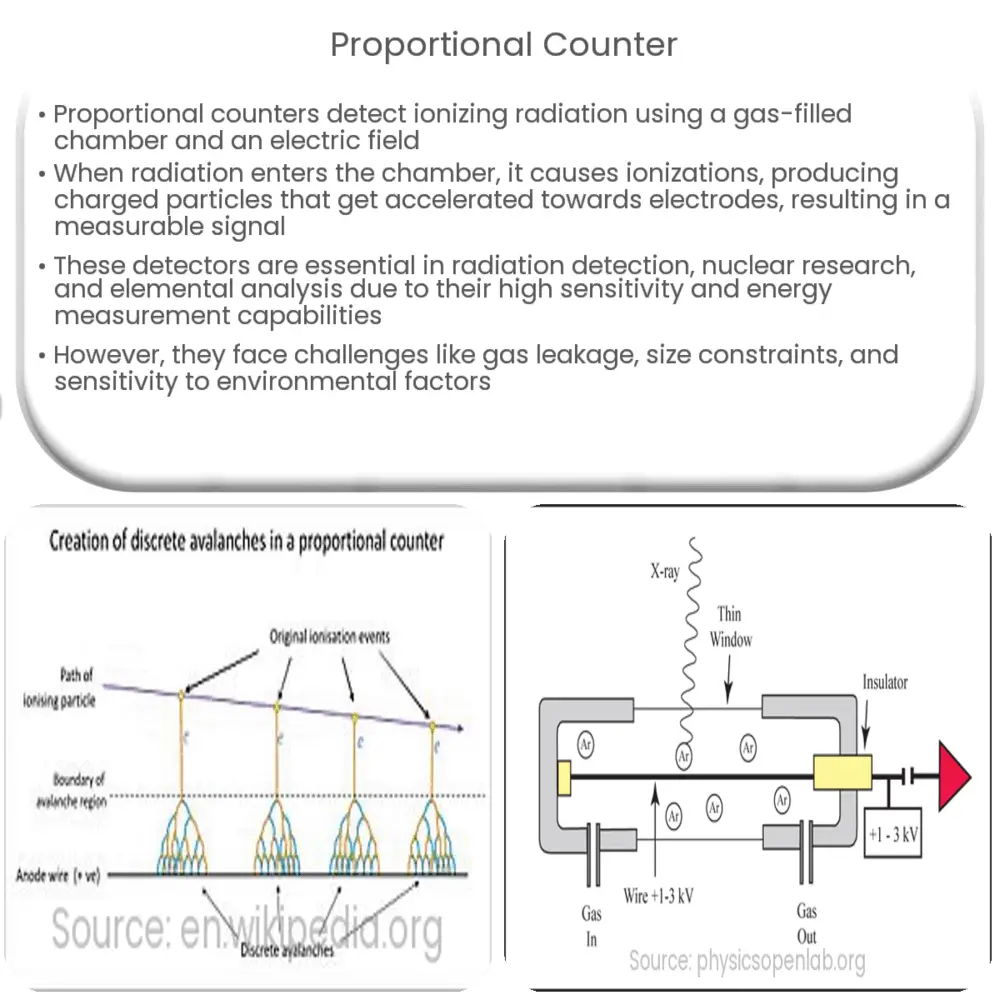A proportional counter is a gas-filled radiation detector used in applications like radiation measurement, nuclear physics, and elemental analysis.

Proportional Counter: A Comprehensive Overview
Introduction
A proportional counter is a type of gaseous ionization detector used in various scientific and industrial applications, including radiation detection, nuclear physics, and elemental analysis. It operates by measuring the charge created by ionizing radiation as it passes through a gas-filled chamber. This article delves into the working principle, components, and applications of a proportional counter, highlighting its significance in radiation detection and measurement.
Working Principle
The core principle behind a proportional counter is the detection and measurement of ionizing radiation through the use of an electric field. When ionizing radiation enters the gas-filled chamber, it interacts with the gas molecules, causing them to ionize and produce charged particles. These charged particles are then accelerated towards the electrodes by an electric field established within the chamber.
As the charged particles gain energy, they cause additional ionizations through a process called gas amplification. The total charge collected at the electrode is proportional to the initial energy deposited by the radiation, thus allowing for accurate measurement and characterization of the radiation. The resulting electronic signal is then processed and analyzed to provide information about the energy and type of radiation detected.
Components
A typical proportional counter consists of several key components:
- Gas-filled chamber: A sealed enclosure filled with a specific gas mixture, typically a noble gas such as argon or helium, mixed with a small amount of a quenching gas, like methane or carbon dioxide. The choice of gas influences the detector’s sensitivity and resolution.
- Electrodes: A central anode wire or tube, and a surrounding cathode, which create the electric field within the chamber. The electrodes are typically made of materials with good electrical conductivity, such as copper or stainless steel.
- Voltage supply: A high voltage source that provides the electric field necessary for the operation of the detector. The voltage is typically set in the range of a few hundred to a few thousand volts, depending on the specific application and the desired level of gas amplification.
- Signal processing electronics: A system of electronic components that amplifies, filters, and analyzes the charge signal generated by the detector. This can include amplifiers, analog-to-digital converters, and multichannel analyzers for spectral analysis.
Applications
Proportional counters have a wide range of applications across various fields, such as:
- Radiation detection and measurement: Due to their high sensitivity and ability to measure the energy of ionizing radiation, proportional counters are commonly used in radiation monitoring, dosimetry, and environmental surveys.
- Nuclear physics: Proportional counters are employed in nuclear research to detect and characterize particles emitted during nuclear reactions, including alpha particles, beta particles, and neutrons.
- Elemental analysis: By using the energy information provided by the detector, researchers can perform elemental identification and quantification through techniques such as X-ray fluorescence and neutron activation analysis.
Advantages and Limitations
Proportional counters offer several advantages over other types of radiation detectors, such as:
- Energy resolution: The ability to measure the energy of incident radiation enables proportional counters to distinguish between different types of radiation and provide detailed spectral information.
- High sensitivity: Due to the gas amplification process, proportional counters can detect low levels of radiation, making them suitable for various applications, including environmental monitoring and trace element analysis.
- Fast response time: Proportional counters generally exhibit a fast response time, allowing for the detection of short-lived events and rapid changes in radiation levels.
- Wide dynamic range: The detector can handle a wide range of radiation intensities without saturation, making it suitable for applications with varying radiation levels.
Despite their advantages, proportional counters also have some limitations:
- Gas leakage and aging: The gas-filled chamber is prone to leakage, and the gas mixture may degrade over time, affecting the detector’s performance. Regular maintenance and gas replacement are required to ensure optimal operation.
- Size and portability: Proportional counters can be bulky and cumbersome, particularly for large-volume detectors or systems with multiple detectors. This may limit their use in field applications or portable devices.
- Sensitivity to environmental factors: The performance of proportional counters can be affected by factors such as temperature, pressure, and humidity, which may require additional compensation or calibration to maintain accuracy.
Conclusion
Proportional counters are versatile and sensitive detectors that have proven invaluable in various scientific and industrial applications. Their ability to measure the energy of incident radiation, combined with their high sensitivity and fast response time, make them an essential tool for radiation detection and measurement, nuclear research, and elemental analysis. However, it is crucial to consider their limitations, such as gas leakage, size, and sensitivity to environmental factors, when selecting a proportional counter for a specific application. By understanding the working principle, components, advantages, and limitations of proportional counters, users can effectively harness their capabilities to address various radiation detection and measurement challenges.

